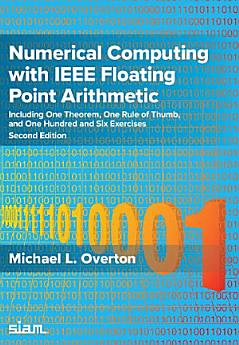Numerical Computing with IEEE Floating Point Arithmeti: Including One Theorem, One Rule of Thumb, and One Hundred and Six Exercises, Second Edition
About this ebook
Every chapter has been extensively rewritten, and two new chapters have been added: one on computations with higher precision than that mandated by the standard, needed for a variety of scientific applications, and one on computations with lower precision than was ever contemplated by those who wrote the standard, driven by the massive computational demands of machine learning.
The second edition of Numerical Computing with IEEE Floating Point Arithmetic includes many technical details not readily available elsewhere, along with many new exercises. It explores the rationale for floating point representation, correctly rounded arithmetic, exception handling, and support for the standard provided by floating point microprocessors and programming languages. Key concepts such as cancellation, conditioning and stability are also discussed. The book emphasizes historical development, from the early history of computing, through the 2008 and 2019 revisions of the floating-point standard, to the latest advances in microprocessor support. It also includes a previously unpublished letter by Donald E. Knuth on the value of gradual underflow, a key requirement of the standard.
This book should be accessible to any reader with an interest in computers and mathematics, including students at all levels. Some basic knowledge of calculus and programming is assumed in the second half. There is enough variety of content that all but the most expert readers will find something of interest.
About the author
Michael L. Overton is a Silver Professor of Computer Science and Mathematics at the Courant Institute of Mathematical Sciences, New York University. He has served several terms on editorial boards of SIAM journals and was Editor-in-Chief of SIAM Journal on Optimization from 1995 to 1999. He is a SIAM Fellow and a Senior Fellow at the Simons Foundation. His research interests are at the interface of optimization and linear algebra, especially nonsmooth optimization problems involving eigenvalues, pseudospectra, stability and robust control. His longstanding interest in floating point arithmetic arose while teaching courses on numerical computing, leading him to write this book.









